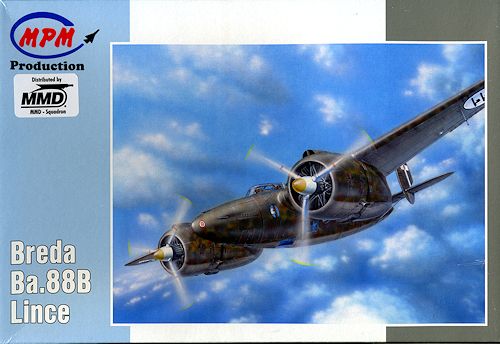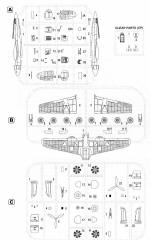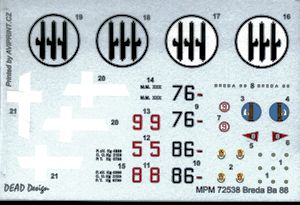
MPM 1/72 Breda Ba.88B 'Lince'
| KIT #: | 72538 |
| PRICE: | $38.00 SRP |
| DECALS: | Two options |
| REVIEWER: | Scott Van Aken |
| NOTES: |

| HISTORY |
The Breda Ba.88 Lince (Italian: Lynx) was a ground-attack aircraft used by the Italian Regia Aeronautica during World War II. Its streamlined design and retractable undercarriage were advanced for the time, and after its debut in 1937 the aircraft established several world speed records. However, when military equipment was installed on production examples, problems of instability developed and the aeroplane's general performance deteriorated. Eventually its operational career was cut short, and the remaining Ba.88 airframes were used as fixed installations on airfields to mislead enemy reconnaissance. It represented, perhaps, the most remarkable failure of any operational aircraft to see service in World War II.
Two Gruppi (Groups) were equipped with the Breda Ba.88 on June 1940, operating initially from Sardinia against the main airfield of Corsica, with 12 aircraft on 16 June 1940 and three on 19 June 1940. The crews soon found that the Bredas were extremely underpowered and lacked agility, but the lack of fighter opposition resulted in them being able to perform their missions without losses.
Later, 64 aircraft became operational serving 7º Gruppo in the North African Theatre with 19º Gruppo stationed in Sardinia, but their performance remained extremely poor resulting in 7º Gruppo being grounded from the end of June until September, when the Italian offensive against British forces started. Of three aircraft used, one was not even capable of taking off, and another could not turn and was forced to fly straight from their base at Castelvetrano to Sidi Rezegh.
With anti-sand filters fitted, a maximum horizontal speed of 250 km/h (155 mph) was reported in some cases and several units were even unable to take off at all. These machines were fitted with "Spezzoniera" Nardi dispensers (with 119 kg/262 lb bomblets), 1,000 rounds for the three 12.7 mm (0.5 in) machine guns and 500 rounds for the 7.7 mm (0.303 in) Bredas. Although the weapons were not loaded to full capacity and the aircraft was lightened by eliminating the rear machine gun, observer, bombs and some fuel, lessening the weight did not substantially affect the aircraft's performance. Such attempts to reduce weight failed to achieve positive results.
By mid-November, just five months after the start of the war on 10 June 1940, most surviving Ba.88s had been phased out as bombers and stripped of useful equipment, and were scattered around operational airfields as decoys for attacking aircraft. This was a degrading end for the new, (theoretically powerful) Breda Ba.88. This action forced the Regia Aeronautica to use totally outdated aircraft in North Africa, such as the Breda Ba.65 and Fiat C.R.32. As an additional problem, Regia Aereonautica remained without any suitable heavy fighter, a notable weakness for a major air arm.
Similar "heavy fighter-zerstorer" projects were developed in several countries. In France, the Breguet Br.690 even with only 1,044 kW (1,400 hp) was more capable than the Ba.88. Despite some problems of reliability, the Br.690 showed a practical usefulness that the Breda never achieved. It is notable that the Ba.88 was also a contemporary of the Messerschmitt Bf 110, with no great differences in hp, weight, P/W ratio or wingload. But the difference in success was immensely in the Bf 110's favour.
Niclot was the only pilot capable of flying this machine at its best (and only in the racer version which was much lighter), while the average pilot was not capable of using it effectively. Despite its impressive world records and aggressive, slim shape, the Ba.88 was a failure and totally unable to undertake combat missions. Its structure was too heavy, wing loading too high, and the engines were quite unreliable with insufficient power. The Piaggio P.XI was quite powerful, but never reliable, leading also to the overall failure of the Reggiane Re.2000. (Hungary substituted the engines with similar ones for the first license-produced examples).
Three Ba.88s were modified by Agusta plant in late 1942, to serve as ground-attack aircraft. The Ba.88M had the wingspan increased by 2 meters (6 ft 6½ in) to alleviate wing-loading problems, dive brakes, Fiat A.74 RC.38 engines and nose armament increased to four 12,7 mm (0,5 in) Breda-SAFAT machine guns. Evaluated at Guidonia, they were delivered to the 103° Gruppo Autonomo Tuffatori at Lonate Pozzolo on 7 September 1943, the day before Italian Armistice. Later they were evaluated by Luftwaffe pilots and that was the last heard of this mediocre aircraft.
| THE KIT |
 Modern
MPM kits are very nicely done in terms of the quality of the molding and the
detail work. However, they are still short run kits so the builder has to keep
that in mind. This one has the usual ejector towers in large parts that will
need to be removed. Some of the things I liked are single piece horizontal stabs
and fins as well as one piece props. I see nothing to be gained by individual
blades with most 1/72 kits and especially so when there is a separate open hub.
Modern
MPM kits are very nicely done in terms of the quality of the molding and the
detail work. However, they are still short run kits so the builder has to keep
that in mind. This one has the usual ejector towers in large parts that will
need to be removed. Some of the things I liked are single piece horizontal stabs
and fins as well as one piece props. I see nothing to be gained by individual
blades with most 1/72 kits and especially so when there is a separate open hub.
But I digress. The interior is really quite well done and there is a goodly amount of detail in the separate sidewalls as well as the framework for the rear gunner's position. Thanks to the high wing, this kit has the fuselage halves cemented together along with the various lower and side clear bits first. The interior is then attached the underside of the large, one piece upper wing before or while attaching the lower wing halves and the engine nacelles.
Each of the nacelles is five pieces comprising the two halves, a firewall and the inner well forward and aft bulkheads. One needs to ensure that the forward well bulkhead is appropriate for either the left or the right side or the main gear will not sit properly. The engine is simply two cylinder rows with a crankcase dome. No pushrods are provided. Each engine is covered with a one-piece cowling which has separate carb intake scoops and exhaust pipes.
Landing gear is very much like a C-47s with the two piece wheel inserted between gear legs and a long retraction brace behind. A tail wheel with a mud guard is also provided. Main gear doors are butt joined to the nacelles and there are small doors for the retractable tail wheel. The tailplanes are keyed to interlock with each other once installed in the rear fuselage so keep that in mind during installation.
 Instructions
are quite well done with Gunze, FS 595 and Italian color information. All three
options are in a desert yellow with bits of green and maroon brown with a
light grey underside. Those who like complex camouflage schemes will really like
these. As the planes were yanked out of service so early in the war, none of the
options have the white theater markings. Do note that the upper surface camo
does wrap around the leading edges of the wings and stabilizers. There is a note
that color camo guides are available on the MPM website. The aircraft are those
assigned to the 76th Squadriglia, 5th Stormo, and the 86th Squadriglia. The
decal sheet is nicely printed and has been darkened so you can see the white
bits.
Instructions
are quite well done with Gunze, FS 595 and Italian color information. All three
options are in a desert yellow with bits of green and maroon brown with a
light grey underside. Those who like complex camouflage schemes will really like
these. As the planes were yanked out of service so early in the war, none of the
options have the white theater markings. Do note that the upper surface camo
does wrap around the leading edges of the wings and stabilizers. There is a note
that color camo guides are available on the MPM website. The aircraft are those
assigned to the 76th Squadriglia, 5th Stormo, and the 86th Squadriglia. The
decal sheet is nicely printed and has been darkened so you can see the white
bits.
| CONCLUSIONS |
It really is too bad that this aircraft was such a dismal failure as it does look very cool. Despite its total lack of success, it did participate in the war and deserves to be in the collection of any WWII Italian aircraft enthusiast.
| REFERENCES |
http://en.wikipedia.org/wiki/Breda_Ba.88
September 2013
Thanks to me for getting this one on deep discount.
If you would like your product reviewed fairly and fairly quickly, please contact the editor or see other details in the Note to Contributors.